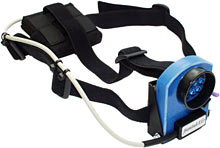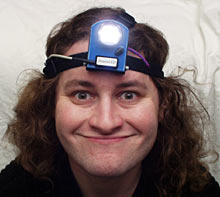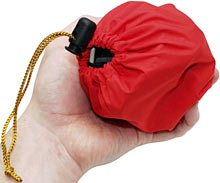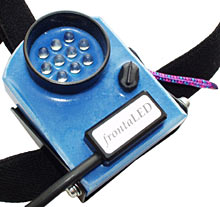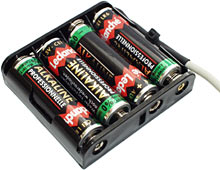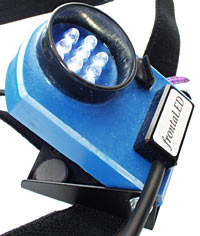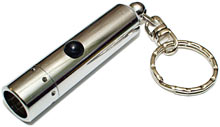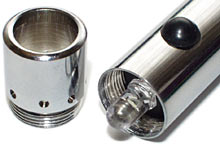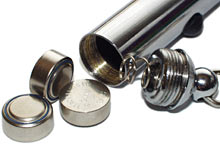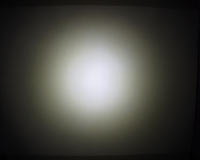
FrontaLED Trekker headlamp and Finewell keyring flashlight
Review date: 26 July 2001.Last modified 03-Dec-2011.
There's a general problem with all normal flashlights, or "torches", as we Commonwealth types like to call 'em.
You have to hold them.
Oh, sure, if you need both hands free then you can try to lean your light against something so it illuminates what you're doing, or you can hold it in your mouth, or use any number of gimcrack devices to affix the thing to your belt or arm or hat-brim.
But, speaking as one who would rather spend somewhat less time walking around with a light clamped between his teeth, trying not to drool all over it even as I also try not to think about what'll happen to my teeth if I fall flat on my face, there's something to be said for headlamps.
And here's a nice one.
Swiss company FrontaLED aim their products at "mountaineers, hikers and rescue teams", but there's nothing stopping you from buying a FrontaLED headlamp for use in less demanding situations. Except, perhaps, the price. Like other lighting gadgets that use an array of high intensity white LEDs, the FrontaLED lamps aren't cheap.
The one I got for review is a "Trekker"; there's another very similar model called the "Alpinist". The only difference between them is that the Trekker has its four-AA-cell battery pack on the back of the elastic webbing that holds it to your head, which makes it nicely balanced. The Alpinist, made for use in very cold climates, has a separate battery pack with a longer cable that lets you keep it under your clothes, so that the batteries don't get too cold to work properly. Both FrontaLED headlamps come with four alkaline AAs pre-installed.
The Alpinist and Trekker each sell for 232 Swiss francs (or 249 Swiss francs including tax, for orders within Switzerland). 232 Swiss francs is, as I write this, about 129 US dollars, or about 253 of the things that we here in Australia are pleased also to refer to as dollars.
Shipping for one or two lamps within Switzerland is 12 francs, within Europe is 18 francs, and to anywhere else in the world is 22 francs - $US6.70, $US10 and $US12.25 respectively, as I write this.
What do you get for your money?
Well, you get a headlamp that can easily be adjusted to accommodate noggins ranging in size from the diminutive to the Brobdingnagian.
You get the opportunity to make a spectacular fashion statement.
You also get a little red drawstring bag, to stop the lamp getting tangled up in stuff when you're not using it.
If you're not yet sold on the idea, don't worry. The FrontaLED lamps have three other big features.
One, the ten-LED lamp array. Permanently potted into a solid polymer block, this lamp is pretty much as waterproof, and as shockproof, as a lamp can be made.
If someone with a baseball bat were to take a swing at the Trekker's lamp while you were wearing it, they might well kill you, but the lamp would very probably be A-OK.
On a less grisly and more practical note, this lamp seems likely to survive all of the abuse that mountain-climbers and cave-explorers inflict upon their equipment. All LED lights have virtually indestructible "bulbs", but the rest of the lamp is often a lot less tough. If you don't smash the Trekker's battery box or sever its power cable, though, it'll keep on trucking.
The Trekker's solid lamp block includes the LEDs, the switch mechanism - of which more in a moment - and voltage regulation hardware as well, which allows the lamp to keep a pretty even output level as its batteries flatten.
The block's about 66mm high, 50mm wide and 22mm deep at its largest points (about 2.6 by 2 by 0.9 inches), but the depth includes the black metal anti-glare shield around the LEDs. The lamp block sits in a metal frame, and is hinged at the bottom; the back of the frame is curved and has a textured rubber backing, which sits snugly on your forehead.
The lamp may be waterproof, but the battery pack isn't. Inside the Velcro-sealed nylon pouch on the back of the webbing there's this unremarkable AA holder. So a dive light this ain't, without a bit of a refit. But I wouldn't be too worried about wearing it in the rain. As, indeed, I have had occasion to do, since I got it for review.
The second big FrontaLED feature is its magic magnetic switch. To turn the lamp on, you just push it forward on its hinge. The round dark thing you can see behind the turned-on lamp in the above picture is a magnet, glued to the lamp holder; a magnetic switch sealed inside the lamp assembly turns on when the lamp moves away from the magnet.
The advantage of this is that you can turn the FrontaLED lamp on and off regardless of how encumbered your hands are. Giant mittens, welding gloves, subtle statements of sporting allegiance; whatever you've got on your hands, you can work this thing. Even if it is your misfortune not to have hands at all, you can turn a FrontaLED on and off.
The switch design means that the FrontaLED light has to be pointing at least slightly down, relative to your head, to turn on. This is how you usually want a headlamp to point, but if you need to see above you it's a bit annoying. No problem, though; just put a piece of something ferromagnetic on the magnet, and the headlamp will be turned on all the time. FrontaLED sell an "'Always on' plaque", with a nifty lanyard attached, but a simple bit of sheet steel will do.
There's a piece of colourful cord sticking out of the side of the FrontaLED lamp, which serves as a simple yet effective "transport lock". When you don't want the light to turn on, you just feed the cord through a hole in the side of the metal lamp holder, and into a matching hole in the side of the lamp. Open the lamp a little and the cord is clamped in place, preventing the lamp from opening far enough to turn on.
The third big FrontaLED feature is its two brightness settings. You toggle the settings by simply turning the light off, then back on again within five seconds. Each time you do this, the lamp alternates between its full-on "Maxi" mode and its considerably dimmer "Eco" mode.
Neither mode is a strobo-vision pulse width modulated dim mode, like the reduced output modes of the Eternalights I review here and here. Maxi mode just feeds the LEDs more milliamps, running them at a current that's further up the LED power-to-efficiency graph than Eco mode.
There's more on brightness and power consumption later in this review.
An artifact of the mode-switching system is that the Trekker's LEDs glow noticeably for a while after it's been turned off. Not enough to really see by, though - you can read a watch in the dark by pressing the just-turned-off Trekker up against it, but that's about it.
Silver bullet
I periodically receive unsolicited commercial e-mail from companies in non-English-speaking nations, who are under the impression that I'm some sort of importer or retailer. They usually offer me the opportunity to buy very large amounts of things I don't want, like reconditioned railway sleepers, real estate in the Middle East, or cargo vessels of dubious seaworthiness.
If the products being promoted have anything to do with the things I actually review, then I ask for review samples in response, rather then send the usual spam complaints. When I sent such a request to Finewell Enterprise, they surprised me by actually sending me one of their LED lights.
If this thing looks a little familiar to you, that's not surprising. Finewell's flashlight is built into a keyring laser pointer case, 14mm wide by 65mm long, not including the chain (0.6 by 2.6 inches). Instead of a laser diode module, it's got a high intensity white LED.
The LED's mounted a bit loosely, but the Finewell flashlight seems solid enough generally. The switch, under its little rubber bubble, is a latching type; if you press it a bit you get momentary operation, and if you press it all the way it stays on until you press it again.
Just like the laser pointers that come in the same sort of case, the Finewell flashlight is powered by three button cells. They're the LR44/SR44 type (a.k.a. G13, WL-14, and 357, among other names); LR44 is alkaline, SR44 is silver oxide. You get three cells with the light.
These fat little buttons are the kings of the 1.5 volt tiny-cell world, with 190 milliamp-hour (mAh) rated capacity for the silver oxide version, and maybe 105 for the alkaline. That's not much compared with the at least 2400mAh you'll get from alkaline AAs, but it's pretty good for a tiny-cell.
Silver oxide cells have a pretty flat discharge curve (their voltage doesn't sag much as their capacity's used up), and they've got almost twice the energy density of alkalines - more capacity, less weight. They've also got a monster shelf life - a decade or more.
Unfortunately, silver oxide batteries don't tolerate high discharge currents even as well as alkalines do. And alkalines aren't that great in this department, to start with. So silver oxide power is great for hearing aids and watches and calculators, but not so hot for a flashlight. In this application, though, there's not much between silver oxide and alkaline; neither is meant to deliver tens of milliamps.
Ask for lots of current - which is what you're doing, in relative terms, when you run a laser diode or single high intensity LED from button cells - and you get less than the rated capacity.
In case you're wondering, the place to buy button cells is an electronics store, or perhaps a battery specialist. You can get them from pharmacies, but only at highly inflated prices. If you don't need a battery for your pacemaker right now, shop somewhere else.
Here in Australia, Jaycar has perfectly all right Chinese made Vinnic SR44s for $AU1.80 each. Electronics places in the States have them for about 75 US cents.
Brightness
So how much light do you get out of these things?
Well, here are my standard test shots, using a carefully calibrated A3 Piece Of Paper as the target.
They're taken 40cm (15.75 inches) from the target, which is hanging with its long axis horizontal. I used my Olympus C-2500L digital camera, on its standard ISO 100 sensitivity setting, at its maximum wide angle, F2.8 setting.
Here's the FrontaLED's output in Maxi mode, with a 1/20th second exposure. It's a bit too bright for the camera...
...but dropping to a 1/40th second exposure dims it down. As usual for LED lights, you get a beautifully even pool of slightly blue-white light. This means excellent colour rendering, no funny bright and dark spots, and generally better "seeing" than incandescent lights can manage. Current white LEDs only have about the same luminous efficiency as halogen incandescent globes, but their whiter light makes them seem brighter.
That said, though, the 10-LED Trekker's output is somewhat dimmer than the light from the 7-LED Tektite Expedition 300 I review in my last comparison.
Here's the Expedition 300 output at 1/40th second. The 300 draws less than 50 milliamps per LED with fresh batteries, so it's not driving its LEDs amazingly hard - well, not by current LED flashlight standards, anyway - and it's got fewer LEDs than the Trekker. But it still wins.
Then again, the Expedition 300 runs from three C cells, which would be less fun to strap to your head than four AAs.
And the Maxi mode output from the Trekker certainly isn't dim - the Expedition 300's just unusually bright for its LED count. The Expedition, like most LED flashlights, also has no regulator circuitry, so its output will fall off as its batteries age. The Trekker keeps its output rather more steady over a range of battery voltages, as you'll see in the "power consumption" section below.
Here's Eco mode, with a 1/20th second exposure. In this mode, the Trekker throws about as much light as the two-LED Tektite Mini-Trek in the last comparison. Roughly penlight brightness, in other words; fine for reading or other close work.
How's the Finewell light?
Not so great.
With a 1/20th second exposure, the Finewell light's output is barely visible. What is visible is that this light's very blue; if someone shines it at you then you'll say it's white, but comparing it with the output from pretty much any other LED flashlight makes it clear that the keyring light's a lot bluer than the average.
The Finewell's output brightens up nicely with a 1/5th second exposure. Now it seems a little brighter - though a lot bluer - than the 2-LED Mini-Trek at 1/20th. In reality, it's got something like a third of the Mini-Trek's output.
Thanks to the logarithmic brightness response of the human eye, the Finewell light isn't as useless as these test shots might suggest. But it's still not terribly bright, and it's far dimmer than the white LED versions of the ISO Standard Keyring Light, the Photon Micro-Light.
The Finewell light's output is pretty much what people expect from a teeny-weeny light. It's brighter than those really weeny "keyhole finder" lights that come built into some keys, and you can use it profitably to find your way around your darkened house at night. But it won't carry far, out in the open.
Power consumption
At full power, the Trekker drew some 265mA from the alkalines it came with, which caused them to sag from their 6.15V total resting voltage (about 1.54 volts per cell) to 5.85V. That's more than 1.5 watts of output.
In Eco mode, the load on the batteries fell dramatically, and so did their voltage sag - they managed 6.05 volts, now, with only 46mA flowing. So now there's about 0.28 watts of power consumed - about 18% of Maxi mode.
The Trekker's current consumption varies oddly with the input voltage. That's because the FrontaLED lamp's regulator, whose aim in life is to keep the lamp at something like full brightness for most of the life of the four AA cells. As the input voltage falls, the regulator hardware keeps the voltage going to the LEDs much the same. You don't get something for nothing, though; a regulator will always eat a bit of power, and the more it has to boost the voltage, the more current it draws from the batteries at whatever voltage they can deliver.
On the plus side, if you've got enough battery voltage that the regulator's stepping the voltage down rather than up, it will draw less current from the batteries than it's delivering to its load.
There's a pretty clear point where the Trekker's regulator hardware gives up trying to run the lamp at close to full brightness - it's around the 4.2 volt mark. At that point, the lamp's drawing its peak current, more than 300mA, for about 1.3 watts of power.
If you're getting 4.2 volts from four AAs, that's only 1.05 volts per cell, which means the batteries are well on the way to dead flatness. The high current draw will help them down the hill, at speed. Above and below this peak-current voltage, the Trekker's current draw is lower.
The lowest voltage my bench power supply can output is 2.77 volts. If you're getting only that much from four AA cells, they're very flat - 0.7 volts per cell indicates that your alkalines have pretty much nothing left, and will be plunging down to zero volts rather soon. But, for what it's worth, the Trekker in Maxi mode still gives a very fair light at 2.77 volts, and draws about 150 milliamps. That's a power consumption figure of a bit more than 0.4 watts.
So this light will work nicely from rechargeable nickel-cadmium (NiCd) or nickel metal hydride (NiMH) AA cells. They've only got 1.2 volts per cell, but they can deliver massive current compared with alkalines without any great voltage droop. Rechargeables have poor charge life if you just sit them on the shelf, but if you use them right after charging you'll get respectable run time in the Trekker. 1500mAh NiMH cells are commonly available; they'll give you more than five hours of run time in Maxi mode, or more than a full day in Eco mode.
The good low voltage performance means that the FrontaLED lamp will work OK from seriously flat batteries - though, of course, not for long. More usefully, it'll also work OK from fewer cells than it's meant to have.
Bridge the spare terminals in the battery box with paper clips or what have you, and you could install just two cells and still get worthwhile performance out of the Trekker. If you're stuck with nothing but a Trekker, a couple of 1.5 volt cells of any size, some wire and some tape, you could make yourself a much-better-than-nothing flashlight.
FrontaLED inform me that there's no certainty that their lamp will be able to start when it's got less than three volts of input; the switching circuitry needs around three volts to work. Once it's on, though, the lamp should keep working down to about 1.8 volts.
Since the normal behaviour of rather flat batteries is to build up a bit of voltage when they're not connected to anything, then slump rapidly when asked to deliver current, you might be able to use one of these lights from surprisingly dead cells, as long as you gave them a while to catch their breath and build up voltage before you turned the light on.
Below the 300mA-plus peak-current point at the regulator's lowest effective voltage, the Trekker's current draw falls off rapidly and the lamp dims just as noticeably. As the voltage rises above the peak-current point, the brightness increase is a lot less dramatic, as the regulator hardware does its thing. The power draw at five volts is about 1.4 watts; it peaks at about 1.55 watts around the 5.7 volt mark, and then it starts to fall as the voltage rises further.
If you run a Trekker from lithium AA cells, you'll be giving it more volts than alkalines can manage. Lithiums sag less under load, and they also have a higher actual terminal voltage - 1.7 volts per cell. So 6.5 volts is perfectly plausible for a fresh set of lithiums. The Trekker draws only about 214mA at that voltage, which is less than 1.4 watts.
FrontaLED quote an eight hour burn time from four alkalines in Maxi mode; that's plausible enough, especially if you use current-model premium-brand high-drain-tolerant AAs. You'll be losing some brightness towards the end, but that's less of a problem than you might think, because the only kind of light that white LEDs know how to emit is white. If you give them less voltage their output slides down, and below a certain threshold it quite abruptly drops to near zero. But they'll keep giving you white light all the way.
Incandescent globes fed by less than their rated voltage emit redder and redder light as the filament cools. In a low-battery situation, an incandescent-globe flashlight will still be emitting around the same amount of energy as you'd get from a similarly specified LED array, but most of that energy will be useless infra-red.
The Finewell light's electrical behaviour was, unsurprisingly, less challenging to measure.
After sitting for a while with no drain, three new SR44 button cells measured 4.71 volts between them. Turning on the little flashlight sucked 'em down to 3.7 volts, though; a heavily-hit 1.23 volts per cell. After that, they only recovered to 4.66 volts.
In operation, the Finewell light draws about 46 milliamps from fresh cells. With no fancy control hardware, that's all going through the LED, and driving it reasonably hard. It's not a ridiculous current level, though, and it'll fall as the button cells age. So the LED in this light should last very well.
Value
There are a whole load of cheaper headlamps than the FrontaLED models. Petzl are probably the best known electric headlamp manufacturer, and their popular incandescent-globe Zoom headlamp costs less than $US40. Even their fancy twin-bulb Duo is still only about half of the price of the FrontaLED lamp.
Petzl's little LED headlamps, the Tikka and new super-compact Zipka, cost about $US35 and $US45, respectively. They're apparently impressively bright, considering that they only have three LEDs. But they still don't have nearly as much output as most incandescent headlamps.
The Princeton Tec Matrix costs about the same as the Zipka, but it's also only got three LEDs. Its Unique Selling Point is that it also comes with a high-output incandescent lamp module, but you have to change the modules to change the brightness.
If three-LED-ish output is good enough, the FrontaLED Eco mode gives you not much less than that light level. And if you need more, you can use Maxi mode.
So as far as respectably bright LED headlamps go, the FrontaLED products seem to be in a class of their own. HDS Systems' very serious-looking Action Lights are considerably brighter thanks to their 24 LED array, but pricing for Action Lights starts at $US274.
The FrontaLED Trekker is built to last, and its dual brightness modes mean you needn't waste the batteries and ruin your night vision when you don't need high output. If you're a night-time outdoorsy type, or just happen to enjoy hanging out underground, I think a Trekker will serve you well. It certainly deals with one of the more irritating events in cavers' lives - Changing Bulbs In The Dark. And it's also far from useless for us geeks who spend more time than we'd like upside down under desks, looking for cables in the shadows.
The little Finewell flashlight, on the other hand, is only worth buying if you find it very cheap. Which is eminently possible - remember, keyring laser pointers are now sold for less than $US5. But the pricing information Finewell gave me doesn't fill me with hope.
Finewell don't sell anything directly, but their Cargo-Insurance-and-Freight wholesale pricing for these lights at the moment means nobody's going to be able to sell them for much of a profit unless they go for at least $US10 a pop. Finewell suggest pricing around the $US17 mark.
There's a problem with this price. It makes the Finewell light not much cheaper than a Photon Micro-Light.
You can find white Photon Micro-Light IIs for $US14.95 ex delivery; that's what Hosfelt charge for them. If you buy direct from the Photon site you'll pay $US19.95, but that includes shipping within the United States. The fancy new Photon 3 isn't a lot more expensive.
There's also no shortage of Photon clones. They're generally fatter and dimmer than the genuine article, but they're still not particularly awkward or uselessly dim, and they're often considerably cheaper. Jaycar Electronics here in Australia have yum cha Photon clones in a variety of LED colours; the white, blue and green-LED ones are for $AU14.95, and the yellow-LED one's only $AU9.95. Divide by two to get approximate US dollar prices, as I write this.
If someone gave you one of the Finewell lights as a present, you'd find it useful. The batteries don't have a ton of capacity but they do have a decent shelf life, the light output's not awful, and the switch lets you use the thing without holding the button down all the time.
But if you want to buy a teeny-light, the Finewell light's outclassed by the Photons. Get a Photon, if you can't find a clone with similar brightness.
